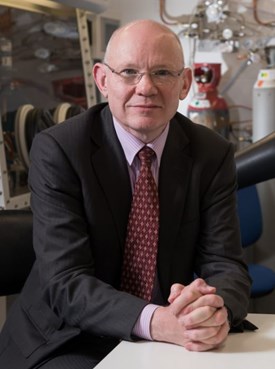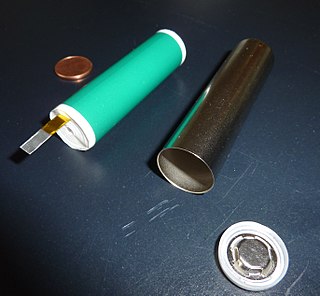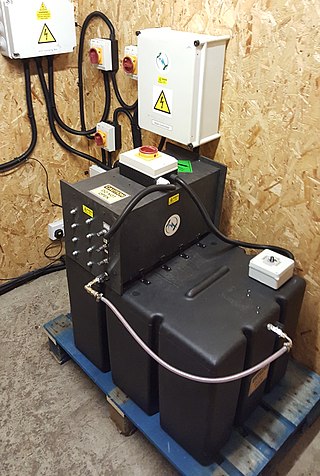
John Bannister Goodenough was an American materials scientist, a solid-state physicist, and a Nobel laureate in chemistry. He was a professor of Mechanical, Materials Science, and Electrical Engineering at the University of Texas at Austin. He is widely credited with the identification and development of the lithium-ion battery, for developing the Goodenough–Kanamori rules in determining the sign of the magnetic superexchange in materials, and for seminal developments in computer random-access memory.
Exide Industries Ltd (Exide), is an Indian multinational storage battery manufacturing company, headquartered in Kolkata, India. It is the largest manufacturer of lead-acid storage batteries and power storage solutions provider in India.

Jeffrey Brian Straubel is an American businessman and electrical engineer. He spent 15 years at Tesla, as chief technical officer until moving to an advisory role in July 2019. In 2023, he was elected to the company's board of directors.

Battery recycling is a recycling activity that aims to reduce the number of batteries being disposed as municipal solid waste. Batteries contain a number of heavy metals and toxic chemicals and disposing of them by the same process as regular household waste has raised concerns over soil contamination and water pollution.

An electric vehicle battery is a rechargeable battery used to power the electric motors of a battery electric vehicle (BEV) or hybrid electric vehicle (HEV).

A battery is a source of electric power consisting of one or more electrochemical cells with external connections for powering electrical devices. When a battery is supplying power, its positive terminal is the cathode and its negative terminal is the anode. The terminal marked negative is the source of electrons that will flow through an external electric circuit to the positive terminal. When a battery is connected to an external electric load, a redox reaction converts high-energy reactants to lower-energy products, and the free-energy difference is delivered to the external circuit as electrical energy. Historically the term "battery" specifically referred to a device composed of multiple cells; however, the usage has evolved to include devices composed of a single cell.

Sir Peter George Bruce, is a British chemist, and Wolfson Professor of Materials in the Department of Materials at the University of Oxford. In 2018, he was appointed as Physical Secretary and Vice President of the Royal Society. Bruce is a founder and Chief Scientist of the Faraday Institution.
A sugar battery is an emerging type of biobattery that is fueled by maltodextrin and facilitated by the enzymatic catalysts.

Saiful Islam is a British chemist and professor of Materials science at the University of Oxford. Previously he was professor of materials chemistry at the University of Bath. Saiful is a Fellow of the Royal Society of Chemistry (FRSC) and a Fellow of the Institute of Materials, Minerals and Mining (FIMMM). In 2020, he received the American Chemical Society Award for Energy Chemistry for his major contributions to the fundamental atomistic understanding of new materials for lithium batteries and perovskite solar cells.

The Henry Royce Institute is the UK’s national institute for advanced materials research and innovation. Its vision is to identify challenges and to stimulate innovation in advanced materials research to support sustainable growth and development. Royce aims to be a "single front door" to the UK’s materials research community. Its stated mission is to “support world-recognised excellence in UK materials research, accelerating commercial exploitation of innovations, and delivering positive economic and societal impact for the UK.”

Home energy storage devices store electricity locally, for later consumption. Electrochemical energy storage products, also known as "Battery Energy Storage System", at their heart are rechargeable batteries, typically based on lithium-ion or lead-acid controlled by computer with intelligent software to handle charging and discharging cycles. Companies are also developing smaller flow battery technology for home use. As a local energy storage technologies for home use, they are smaller relatives of battery-based grid energy storage and support the concept of distributed generation. When paired with on-site generation, they can virtually eliminate blackouts in an off-the-grid lifestyle.

Electric cars have a different environmental footprint than conventional internal combustion engine vehicles (ICEVs). While aspects of their production can induce similar, less or alternative environmental impacts, they produce little or no tailpipe emissions, and reduce dependence on petroleum, greenhouse gas emissions, and health effects from air pollution. Electric motors are significantly more efficient than internal combustion engines and thus, even accounting for typical power plant efficiencies and distribution losses, less energy is required to operate an EV. Manufacturing batteries for electric cars requires additional resources and energy, so they may have a larger environmental footprint from the production phase. EVs also generate different impacts in their operation and maintenance. EVs are typically heavier and could produce more tire and road dust air pollution, but their regenerative braking could reduce such particulate pollution from brakes. EVs are mechanically simpler, which reduces the use and disposal of engine oil.
Serena Corr is a chair in Functional Materials and Professor in Chemical and Biological Engineering at the University of Sheffield. She works on next-generation battery materials and advanced characterisation techniques for nanomaterials.
Linda Faye Nazar is a Senior Canada Research Chair in Solid State Materials and Distinguished Research Professor of Chemistry at the University of Waterloo. She develops materials for electrochemical energy storage and conversion. Nazar demonstrated that interwoven composites could be used to improve the energy density of lithium–sulphur batteries. She was awarded the 2019 Chemical Institute of Canada Medal.

Kristina Edström is a Swedish Professor of Inorganic Chemistry at Uppsala University. She also serves as Head of the Ångström Advanced Battery Centre (ÅABC) and has previously been both Vice Dean for Research at the Faculty of Science and Technology and Chair of the STandUp for Energy research programme.
Emma Kendrick is Professor of Energy Materials at the University of Birmingham where her work is focused on new materials for batteries and fuel cells. She is a Fellow of the Royal Society of Chemistry and Institute of Materials, Minerals and Mining.
Khalil Amine is a materials scientist at Argonne National Laboratory, an Argonne distinguished fellow, and group leader of the Battery Technology group. His research team is focused on the development of advanced battery systems for transportation applications. In addition to his Argonne appointment, he is an adjunct professor at Stanford University, Imam Abdulrahman Bin Faisal University, Hong Kong University of Science & Technology, King Abdulaziz University, Hanyang University, and Peking University.

Lithium batteries are primary batteries that use lithium as an anode. This type of battery is also referred to as a lithium-ion battery and is most commonly used for electric vehicles and electronics. The first type of lithium battery was created by the British chemist M. Stanley Whittingham in the early 1970s and used titanium and lithium as the electrodes. Unfortunately, applications for this battery were limited by the high prices of titanium and the unpleasant scent that the reaction produced. Today's lithium ion battery, modeled after the Whittingham attempt by Akira Yoshino, was first developed in 1985.

Alkaline sulfur liquid battery (SLIQ) is a liquid battery which consists of only one rechargeable liquid and a technology which can be used for grid storage.
Lohum is an Indian battery developer and manufacturer, specialising in lithium-ion technology for electric vehicles. The company headquartered in Noida, Uttar Pradesh.













